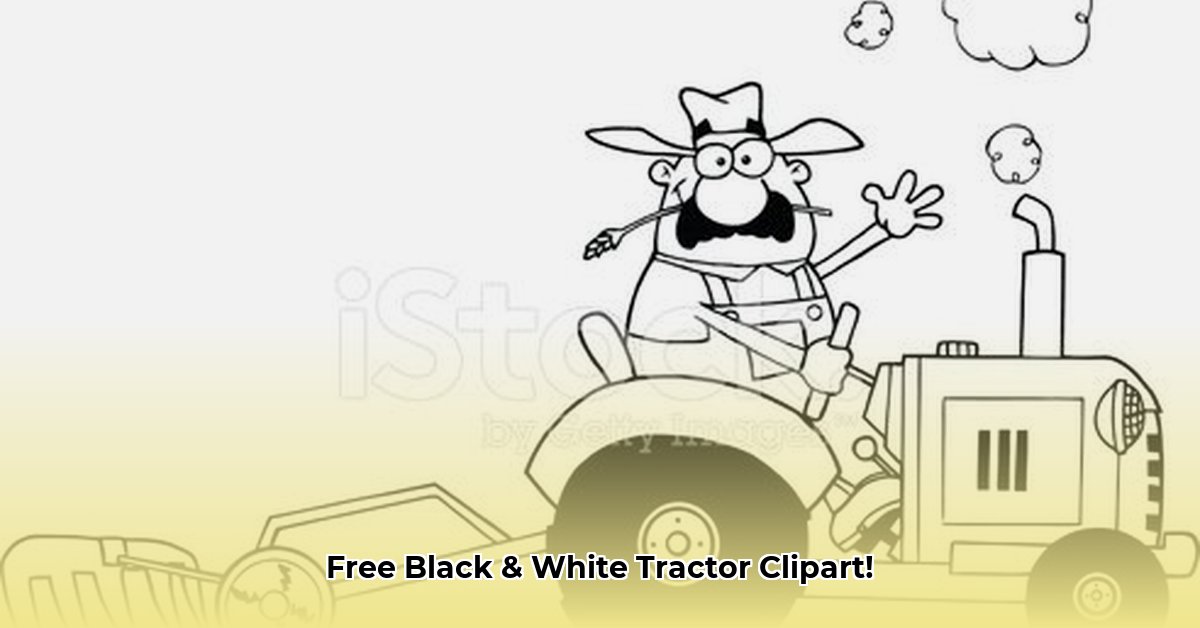
Tractor Clip Art: A Visual Analysis of Sustainable Agriculture Communication
The readily available abundance of black and white tractor clip art online, readily accessible through platforms such as ClipArtMag and Vecteezy, initially suggests a burgeoning awareness of sustainable agriculture within visual communication. However, a closer examination reveals limitations in its current form and necessitates a strategic shift towards more comprehensive and representative imagery. For more examples, check out this tractor clip art site. This article analyzes the current state of tractor clip art, identifies its shortcomings, and proposes actionable recommendations for stakeholders across the agricultural sector.
Exploring the Landscape of Black and White Tractor Clip Art
A preliminary analysis reveals thousands of black and white tractor images available online. This ease of access presents a double-edged sword. While convenient, it highlights a reliance on simplistic imagery that fails to capture the nuanced realities of contemporary, sustainable agricultural practices. This reliance on monochrome imagery raises concerns about the effectiveness of communication surrounding sustainable agriculture. How can we effectively convey the vibrancy and complexity of sustainable farming using only black and white images? The answer, in short, is we can't.
Limitations of Current Imagery: Beyond the Monochrome Tractor
The primary deficiency of predominantly black and white tractor clip art lies in its inability to convey the richness and diversity inherent in sustainable agriculture. The vibrant colors reflecting healthy crops, the varied textures of the soil, and the sophisticated technologies employed in modern farms are all lost in monochrome representation. Furthermore, these images often depict only the tractor itself, neglecting the human element, the intricate techniques, and the crucial environmental considerations central to sustainable agriculture. This limited perspective creates a skewed narrative, failing to fully represent the multifaceted nature of the field. For example, the rich greens of a diverse cover crop or the warm browns of healthy soil are essential visual cues conveying sustainable practices, and these are lost in a black-and-white representation.
Actionable Recommendations for Enhanced Visual Communication
To address the limitations of current imagery and foster more effective communication, stakeholders must adopt a more holistic approach. The following recommendations are tailored to specific groups:
1. Sustainable Agriculture Organizations:
- Short-Term (1 year): Commission high-resolution color photographs and illustrations depicting various sustainable farming practices, including diverse planting, innovative water management, and soil conservation techniques. Integrate these into existing online image libraries.
- Long-Term (3-5 years): Invest in dynamic visual content, such as interactive videos and augmented reality experiences, to create immersive learning experiences showcasing sustainable farming techniques.
2. Educational Institutions:
- Short-Term (1 year): Update educational materials with high-quality, engaging images that enhance student understanding and improve learning comprehension.
- Long-Term (3-5 years): Integrate visual literacy training into curricula, empowering students to create their own visuals about sustainable agriculture.
3. Marketing and Advertising Agencies:
- Short-Term (1 year): Encourage clients to use images accurately reflecting sustainable farming practices, avoiding "greenwashing" and promoting transparency.
- Long-Term (3-5 years): Conduct research on the effectiveness of diverse visual communication strategies, using data-driven insights to optimize messaging.
4. Software Developers:
- Short-Term (1 year): Develop searchable databases of high-quality images of sustainable agricultural practices, enhancing accessibility for users.
- Long-Term (3-5 years): Create tools simplifying the creation and sharing of high-quality imagery, empowering wider participation in visual communication about sustainable agriculture.
Future Research Directions: A Path Towards Granular Understanding
Further research is needed to fully understand the current landscape of agricultural imagery. This includes:
Comparative Analysis: A quantitative comparison of black-and-white versus color imagery across various online platforms (stock photo sites, social media etc.) to determine usage trends.
Semantic Analysis: Analysis of keywords and descriptions associated with these images to uncover prevailing narratives and misconceptions surrounding sustainable agriculture.
Regulatory Implications: Investigation into intellectual property rights and potential legal challenges in using agricultural imagery.
Conclusion: Investing in a Visually Rich Future
The widespread use of black and white tractor clip art points to a need for visual tools to effectively communicate about sustainable agriculture. However, the limitations of this current imagery necessitate a collective effort to enhance the quality and diversity of available visuals. By investing in high-quality, color imagery that showcases the full spectrum of sustainable farming practices, we can significantly improve communication, promote understanding, and ultimately accelerate the adoption of environmentally responsible agricultural techniques.